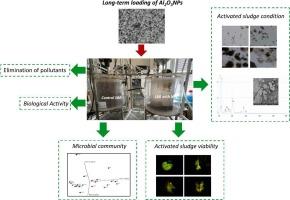氧化铝纳米颗粒对序批式反应器中活性污泥性能的长期影响
Q1 Environmental Science
Environmental Nanotechnology, Monitoring and Management
Pub Date : 2025-08-23
DOI:10.1016/j.enmm.2025.101096
引用次数: 0
摘要
纳米粒子由于其广泛使用和对生态系统的有害影响而引起了全球关注。虽然废水处理厂(WWTPs)被视为环境中纳米化合物的潜在来源,但氧化铝纳米颗粒(Al2O3NPs)对废水处理的影响仍不确定。本研究旨在探讨废水中Al2O3NPs及其散装对应物对序批式反应器(sbr)中污染物去除效果、活性污泥性能、内部生物活性/活力以及微生物群落多样性和结构的长期影响。观察到Al2O3NPs的存在会引起废水中COD、NH4+- N和SOP去除效率的变化,并在长时间暴露时影响硝化过程。废水中的Al2O3NPs在污泥中积累,影响污泥形态,降低微生物活力和生物活性。此外,16S rRNA的高通量测序表明,Al2O3NPs会影响SBR中活性污泥的微生物丰富度和多样性。相比之下,含有散装对应物的废水对污水处理厂的能力没有负面影响。本研究为Al2O3NPs对生物废水处理过程的影响提供了新颖而重要的见解,对风险评估程序具有重要意义。本文章由计算机程序翻译,如有差异,请以英文原文为准。

Long-term effect of aluminum oxide nanoparticles on activated sludge performance in sequencing batch reactors
Nanoparticles (NPs) have raised global concerns due to their extensive use and detrimental impacts on ecosystems. While wastewater treatment plants (WWTPs) are viewed as potential sources of nanocompounds in the environment, the influence of aluminum oxide nanoparticles (Al2O3NPs) on wastewater treatment remains uncertain. This study aimed to explore the long-term effects of wastewater-borne Al2O3NPs and their bulk counterparts on the effectiveness of pollutant removal within sequencing batch reactors (SBRs), activated sludge performance, internal biological activity/viability, and microbial community diversity and structure. The presence of Al2O3NPs was observed to induce alterations in the removal efficiency of COD, N, and SOP from wastewater, as well as impacting the nitrification process during prolonged exposure. Al2O3NPs in wastewater accumulated in the sludge, affecting its morphology and diminishing microbial viability and biological activity. Additionally, high throughput sequencing of 16S rRNA indicated that Al2O3NPs could impact on the microbial richness and diversity of activated sludge in the SBR. In contrast, wastewater containing bulk counterparts did not negatively influence the capacity of wastewater treatment plants. This research provides novel and crucial insights into the effects of Al2O3NPs on the biological wastewater treatment process, holding significance for risk assessment procedures.
求助全文
通过发布文献求助,成功后即可免费获取论文全文。
去求助
来源期刊

Environmental Nanotechnology, Monitoring and Management
Environmental Science-Water Science and Technology
CiteScore
13.00
自引率
0.00%
发文量
132
审稿时长
48 days
期刊介绍:
Environmental Nanotechnology, Monitoring and Management is a journal devoted to the publication of peer reviewed original research on environmental nanotechnologies, monitoring studies and management for water, soil , waste and human health samples. Critical review articles, short communications and scientific policy briefs are also welcome. The journal will include all environmental matrices except air. Nanomaterials were suggested as efficient cost-effective and environmental friendly alternative to existing treatment materials, from the standpoints of both resource conservation and environmental remediation. The journal aims to receive papers in the field of nanotechnology covering; Developments of new nanosorbents for: •Groundwater, drinking water and wastewater treatment •Remediation of contaminated sites •Assessment of novel nanotechnologies including sustainability and life cycle implications Monitoring and Management papers should cover the fields of: •Novel analytical methods applied to environmental and health samples •Fate and transport of pollutants in the environment •Case studies covering environmental monitoring and public health •Water and soil prevention and legislation •Industrial and hazardous waste- legislation, characterisation, management practices, minimization, treatment and disposal •Environmental management and remediation
 求助内容:
求助内容: 应助结果提醒方式:
应助结果提醒方式:


